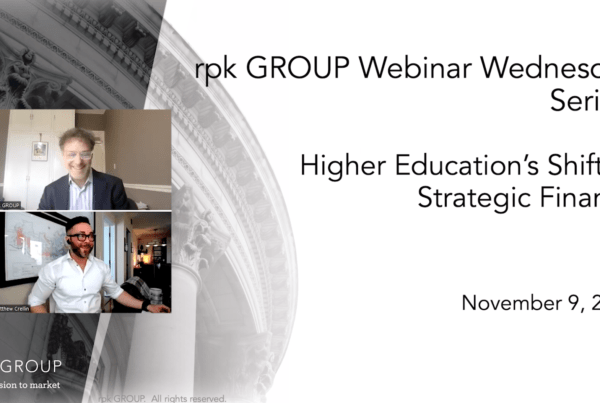Autumn always presents an important annual milestone for rpk GROUP. We’ve been in the business of learning about strategic finance and sharing our findings for a dozen years now.
During that period, we’ve come up with a good definition of strategic finance:
Strategic finance is the consideration of the return on investment generated by all institutional resources (people, time and money), and the continuous effort to shift those resources toward stated institutional strategy and goals.
That definition is a good start. So, what else have we learned? Below I’ve captured our top strategic finance “aha’s”.
- Focusing on Outcomes – ‘Good’ finance has often been equated with a balanced budget. While budget balancing is, of course, an essential element of good financial management, shepherding a balanced budget does not focus on the more essential question: What was achieved in the use of those resources?
- It’s About More Than Just Dollars – Strategic finance considers more than just dollars. All resources must be reflected, including dollars, people and especially the time those people invest at the institution.
- Understanding Return on Investment (ROI) – The outcomes-based focus of strategic finance moves us toward an understanding of ROI. ROI, however, may mean different things for different stakeholders. For students, ROI may reflect their investment of dollars and time toward a completion. For an institution, ROI might focus more on net revenue. For a system, ROI could include avoiding duplication of programs and services. For a state, ROI might ultimately be seen in an increasingly educated citizenry—one that contributes meaningfully to a thriving local economy.
- Institutions and Systems Live on a Continuum – As we consider an institution’s or system’s capacity to operate under a strategic finance lens, we must recognize that they live on a continuum of capacity. That capacity ranges from the historic emphasis on budget balancing, to a shift toward optimization of the current business model, all the way to deep emphasis throughout the institution/system on return on investment
- Getting the Prescription Right – Once an institution’s or system’s place on the continuum is clear, the right ‘prescription and dosage’ can be determined. Is the need simply for exposure to the strategic finance lens? Or a deeper investment in analysis and professional development?
- Building Capacity – The most important outcome from applying a strategic finance lens is informed decision-making, i.e., making decisions that are informed by both mission and data.
- Applying a Change Management Model – Change happens at the speed of trust. Constant communication, opportunities for input and feedback, and authentic engagement with all stakeholders are essential for actual data utilization.
- Remember That You are Changing Culture – Strategic finance is about more than numbers. Applying a strategic finance lens deeply into an institution or system ultimately requires a change in culture.
It feels as if higher education is ready to take another step toward strategic finance. It may be that the industry is being pushed in that direction due to external factors and the needs of students and employers. Whatever the motivation, we’ll all be served better in the end as this strategic finance lens is applied ever more deeply into our institutions and systems.
